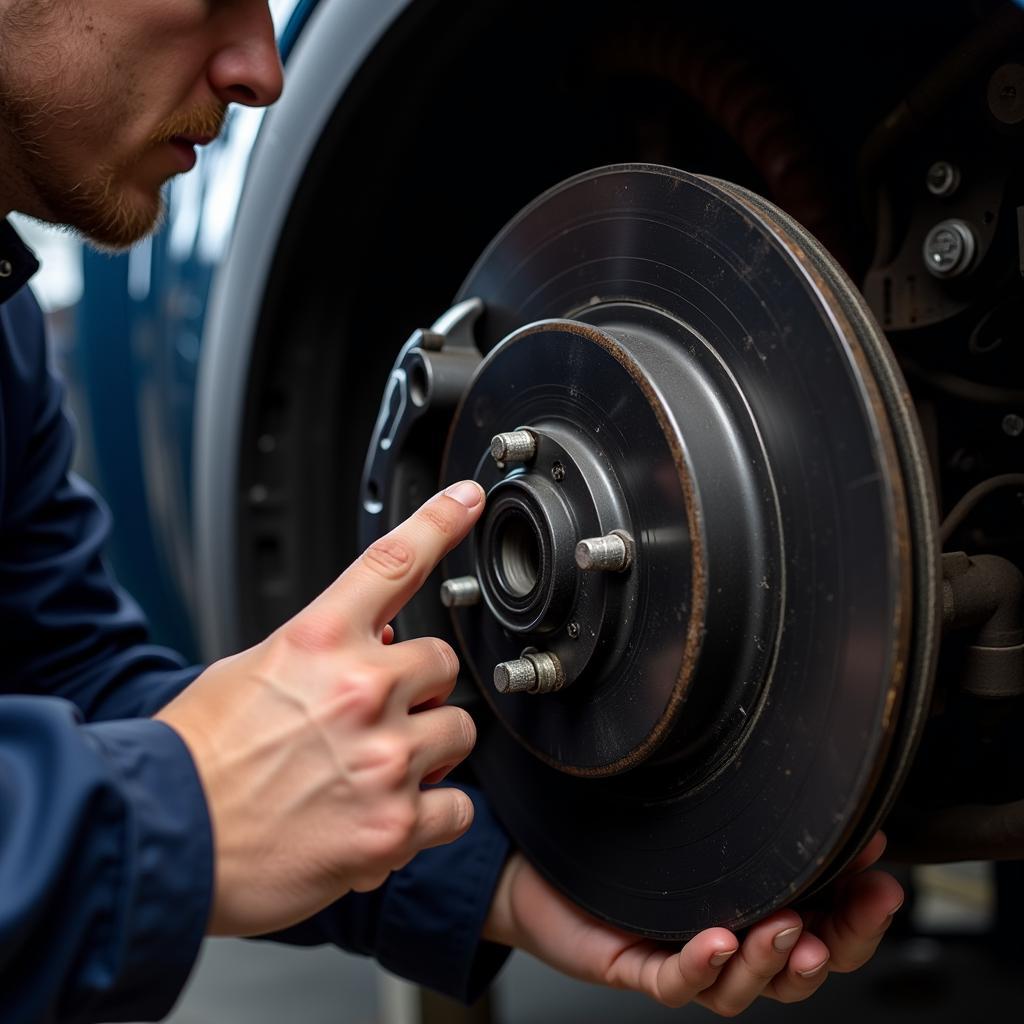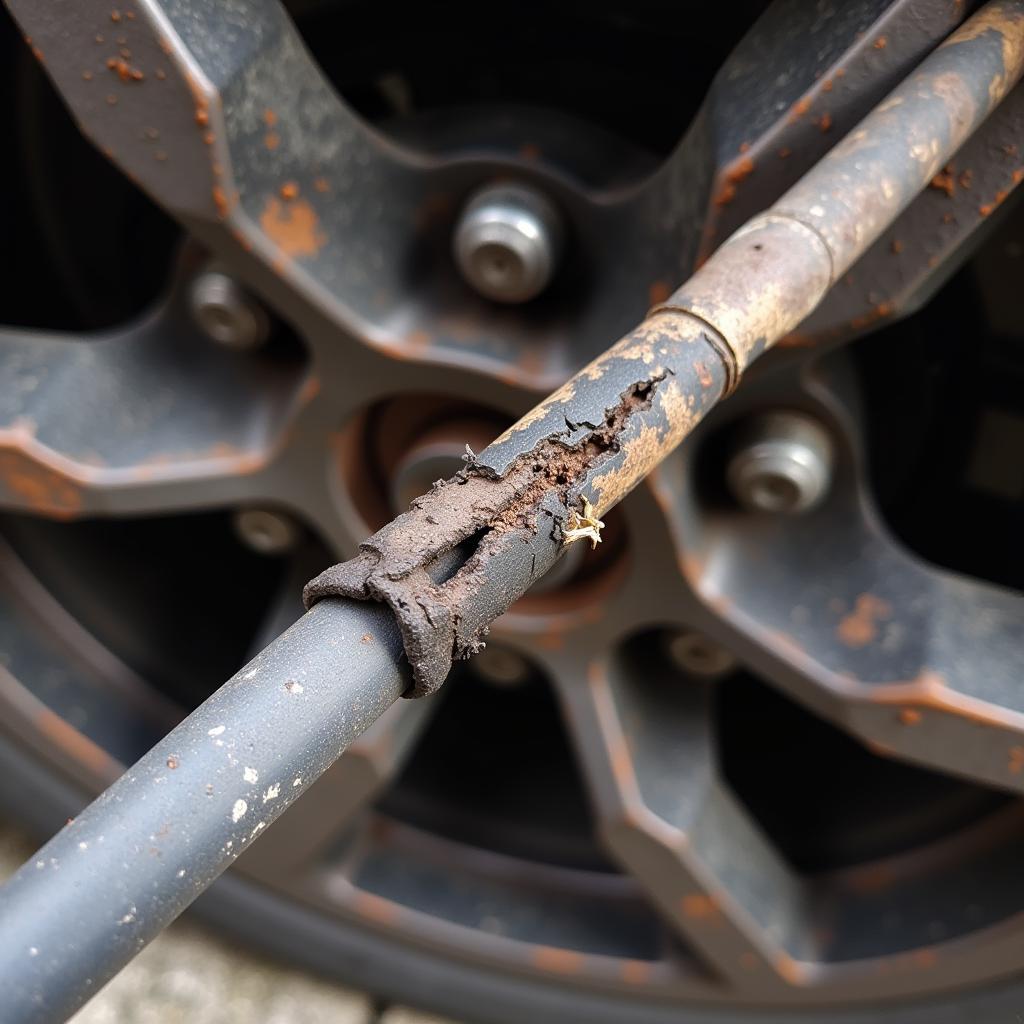The dreaded brake warning light on your Mini F56 dashboard can be a cause for concern. It’s a clear signal that something needs attention, but deciphering the exact issue can be tricky. This comprehensive guide is here to help you understand the different reasons behind the Mini F56 brake warning light and guide you through potential solutions.
Common Causes of the Mini F56 Brake Warning Light
There are several reasons why your Mini F56’s brake warning light might illuminate. Let’s delve into the most common culprits:
- Worn Brake Pads: The most frequent cause is worn brake pads. Your Mini F56 is equipped with brake pad wear sensors that trigger the warning light when the pads thin out, indicating it’s time for a replacement.
- Low Brake Fluid: Brake fluid is the lifeblood of your braking system, transmitting force to engage the brakes. If the fluid level drops too low, often due to a leak, the warning light will activate.
- Faulty Brake Light Switch: The brake light switch is responsible for turning on your brake lights when you press the pedal. A malfunctioning switch can confuse the car’s computer, leading to the brake warning light illuminating.
- ABS Issues: Your Mini F56’s Anti-lock Braking System (ABS) is crucial for maintaining control during hard braking. A problem with the ABS module, wheel speed sensors, or wiring can trigger the warning light.
- Electronic Parking Brake Fault: If your Mini F56 is equipped with an electronic parking brake, a fault within the system can trigger the brake warning light. This could be due to a sensor issue or a problem with the electronic control unit.
Diagnosing the Problem
While some issues, like worn brake pads, are relatively straightforward, others require more in-depth diagnostics. Here’s a step-by-step approach:
- Check Your Brake Fluid: Locate the brake fluid reservoir under the hood and check the fluid level. If it’s below the minimum mark, add the appropriate DOT 4 brake fluid. However, simply adding fluid won’t solve a leak, so further inspection is crucial.
- Inspect Your Brake Pads: Take a look at your brake pads through the spaces between the wheel spokes. If they appear significantly thinner than the surrounding metal, it’s time for a replacement.
- Scan for Trouble Codes: A professional-grade OBD-II scanner can read trouble codes stored in your Mini F56’s computer, providing valuable insights into the specific issue triggering the warning light.
- Consult a Professional: If the issue persists or you suspect a more complex problem like an ABS or electronic parking brake fault, it’s best to seek professional help from a qualified Mini technician.
What to Do When the Brake Warning Light Comes On
The brake warning light is a serious signal, demanding immediate attention. Here’s what to do:
- Pull Over Safely: Find a safe location to pull over as soon as possible. Driving with compromised brakes is extremely dangerous.
- Assess the Situation: If you suspect low brake fluid or severely worn brake pads, avoid driving further and call for a tow truck.
- Seek Professional Help: Unless you’re confident in your mechanical abilities, it’s always advisable to have a professional diagnose and repair any brake system issues.
Preventing Future Brake Warning Lights
 Mini F56 Brake Pad Inspection
Mini F56 Brake Pad Inspection
Proactive maintenance is key to preventing brake warning lights and ensuring optimal braking performance:
- Regular Brake Inspections: Schedule brake inspections with every oil change or as recommended in your Mini F56’s owner’s manual.
- Timely Brake Pad Replacement: Don’t wait for the warning light to illuminate. Replace your brake pads proactively based on your driving habits and manufacturer recommendations.
- Brake Fluid Flush: Brake fluid absorbs moisture over time, reducing its effectiveness. Have your brake fluid flushed every 2 years or as recommended by Mini.
- Address Warning Signs Early: Don’t ignore unusual noises, vibrations, or changes in brake pedal feel, as these can be early indicators of developing brake problems.
Mini F56 Brake Warning Light: Your Safety is Paramount
“Ignoring your Mini F56’s brake warning light is like playing a high-stakes game of chance with your safety,” warns John Smith, a senior Mini technician with over 15 years of experience. “Addressing the issue promptly and proactively maintaining your braking system is crucial for ensuring your peace of mind on the road.”
Frequently Asked Questions
Q: Can I drive my Mini F56 with the brake warning light on?
A: It’s highly discouraged to drive with the brake warning light on. Pull over safely and have your vehicle towed to a trusted mechanic.
Q: How much does it cost to fix a Mini F56 brake warning light?
A: The cost varies depending on the underlying cause. Worn brake pads are less expensive to replace than complex ABS module issues.
Q: How often should I change my Mini F56’s brake pads?
A: Brake pad lifespan varies greatly depending on driving conditions and habits. Consult your owner’s manual or a Mini technician for personalized recommendations.
Q: Can I add any brake fluid to my Mini F56?
A: Use only DOT 4 brake fluid, as specified in your owner’s manual. Using the wrong type of fluid can damage your braking system.
Taking Control of Your Mini F56’s Brakes
Understanding your Mini F56’s brake warning light and addressing the underlying issues is paramount for ensuring your safety and the longevity of your vehicle. By following the advice and guidance provided in this guide, you can confidently tackle brake-related challenges and enjoy worry-free driving. Remember, preventative maintenance is key to avoiding costly repairs and potentially dangerous situations.
For more detailed information on specific brake warning light issues related to your Mini F56, you can explore our dedicated guides: mini f56 brake pad warning light and mini f56 brake pad warning reset.

